Our comprehensive guide to Spurdog fishing, everything you need to know to catch this member of the shark family from boat and shore.
Spurdog are a member of the shark family and were loathed as a pest and nuisance fish by commercial fishermen in the 19th century and first half of the 20th century for the damage they caused to both their nets and to hooked fish caught on long-lines. They became more popular when a use for their liver oil was found. The liver of the spurdog is overly large for the size of the fish and was a valuable commodity for using in fish oil products, cosmetics, and health supplements. Spurdog flesh was also used to turn into fish meal. Spurdog have since been caught commercially for human food, the flesh often being marketed at the fishmongers and in the Fish & Chip shops as “flake”.
This sudden commercial popularity saw the spurdog stock numbers crash massively during the 1970’s and early 1980’s. In 2010 the European Union imposed a zero Total Allowable Catch limit stopping commercial fishermen from retaining any caught spurdog. Thankfully, although still classed as vulnerable in European waters, their numbers are slowly increasing again.
The spurdog is shark shaped, so physically looks a little like several other smaller British sharks, principally the tope and smoothhound. However, the spurdog is the only British and Irish Shark with a sharp spine situated on the front of both dorsal fins. These spines are large and obviously protrude well clear of the fin. The spines can inflict a serious wound and the bacteria on the spine can cause infections, so some care is needed when handling these fish.
The body shape is shark shaped but slim with a pointed snout, large eyes. The pectoral fins are roughly triangular and broad in shape. Spurs also lack an anal fin.
Its colouration is typically dark grey on the back with scattered light spots on the body, especially the flanks. The belly is a lighter grey. In very deep water the spurdogs back can be almost dark slate grey with a hint of blue.
Spurdog give birth to live young, gestation being long from 18 to 22 months and the litter ranging from 3 to 11 pups from 8 to 13-inches in length, the number and size being dependent on the size of the mother. Males are mature at about 22-inches in length and females around 30-inches.
They can grow to between 25lbs and 30lbs, but a specimen sized spur in most areas would be in the region of 12 to 13lbs currently, though fish in the high teens are not that uncommon given the improvement in overall stock levels over recent years.
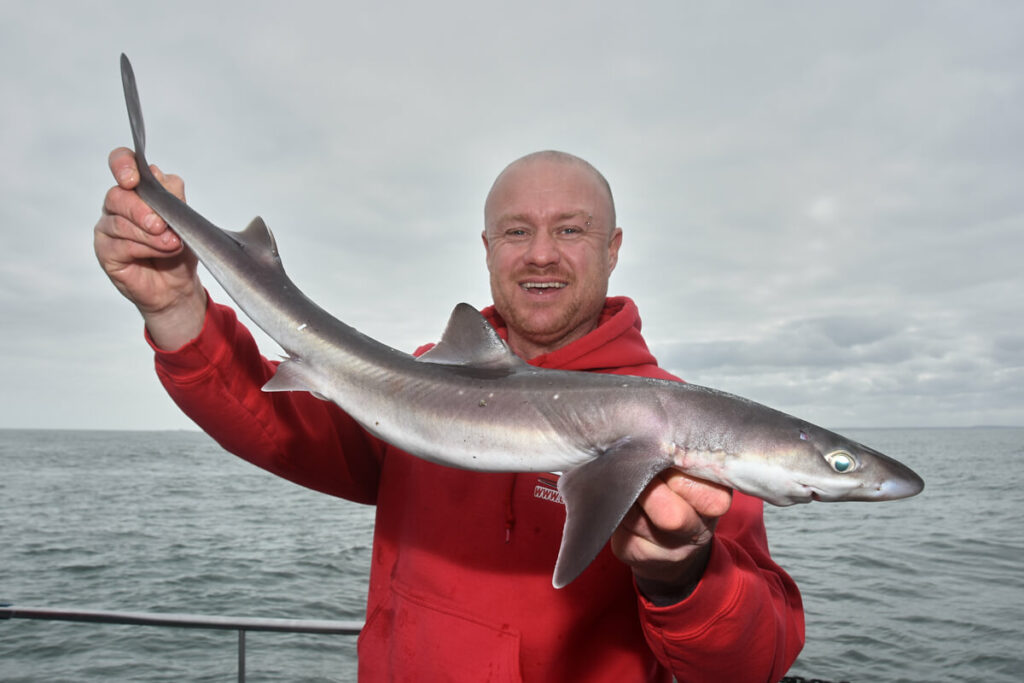
Spurdog are found throughout the Mediterranean and into the Black Sea, in the upper section of North Africa, all along the European coast, inside the North Sea and throughout Norway to just beyond the Russian border. They are also found around Iceland and down the east coast of America almost to Florida.
They are common all around the UK and Ireland with hotspots in the southwest approaches of the English Channel, inside the Bristol Channel, the Irish Sea and off the west coast of Scotland. They are also found all around Ireland with major concentrations in the Irish Sea, off the Cork and Kerry coast, Donegal, and Northern Ireland.
Typically, spurdogs are found in depths from 40-feet to 600-feet but can be resident in much greater depths exceeding 2000-feet. They come shallower as light levels fall in the evening following up the smaller plankton feeding fish such as herring right up to the surface. They are found mainly over a soft sandy or muddy seabed, but also take up residence around deep water wrecks and reefs.
They form huge unisex schools of fish of different sizes and can wipe out food in a given area making them nomadic as they seek new feeding grounds. It’s this long gestation period and their large overall size before maturity is reached, that makes them vulnerable to overexploitation.
Their diet includes a range of small fish such as herring, mackerel, spart, sandeels, pilchards and garfish when feeding higher up in the water column, but cod, whiting, haddock, flatfish, dragonets and crabs when feeding near the bottom. They will also lift in the water column to intercept squid and octopus when they are plentiful.
They can be caught all year round, especially in areas with access to very deep water. However, their numbers tend to concentrate in the spring and autumn periods with March to May and late September to early December being especially good in many areas.
As is so often the case when boat fishing, it’s the influence of the tides on the boat that governs the best tides for fishing. In most areas, due to fishing in water in excess of 150ft deep and being well offshore, then it’s the smaller neap tides that will usually be the best for fishing when the boat’s drift speed is lessened. On the bigger tides, the drift speed is likely to be too fast to keep the baits fully in the fishing zone.
Regarding the state of the tide, the spurs tend to go off the feed either side of slack water, both high and low, when there's little in the way of flow. However, at slack water, try fishing up in the water column say 20 to 40-feet above the seabed as the packs of spurs will sometimes lift off the seabed at this time to target food fish.
The best period is when the tide is flowing during the middle hours of the flooding tide, and again during the ebb tide. The spurs will be tight to the seabed at this time, certainly under 20-feet off the bottom. Even when the tide is flowing, the shoal may sit at roughly 2/3rds depth or even at mid depth if there are food fish available. It’s a case of finding out where they are feeding and then concentrating at that depth.
Being deep water living mostly, they are not affected by weather patterns too much. Even so they will, after prolonged periods of rough seas with a heavy swell, move out into water in excess of 25-feet, but quickly come back in again. This is probably more to do with the outward migration of food fish at this time than their inability to handle rougher seas.
Ideal conditions for spurs, even in deep water, are relatively light seas with a little swell that makes the baits jig up and down off the seabed. Cloudy days are better than bright sunny days when light levels are high. They will also tend to be caught in better numbers when the angle of the sun is lower during the day, so typically early morning and late afternoon.
If you can hit the spur grounds a couple of tides before a big blow moves in, in the autumn, then the incoming low pressure can induce some serious feeding and big catches can be made. The opposite is true if you venture out a couple of days after a prolonged gale as the sea settles, it takes time for the food fish and the spurs to move back in, especially in water under 200-feet deep.
Due to the depths you’re likely to be fishing, and the average size of fish likely, robust tackle needs to be chosen. Standard boat rods in the 20/30lb class will suit most situations allied to a multiplier, either a star drag or lever drag, and holding 300-yards of 30lb braid, plus some mono backing are ideal. In shallower water (up to 150-feet) and lighter tides a straight 20lb class rod is perfect, but in deeper water and when the boat drift is faster requiring heavier leads, then the 30lb is the better choice. Length needs to be 7ft 6in or slightly longer.
Although there are not many about, some modern rods for braid are rated as 20/40lb class and these are as good as it gets for spurdog fishing having the sensitivity in the tip and upper mid-section to give maximum sport with average spurs, but with power in the lower mid-section and a stiff butt providing real lifting power when bigger fish are hooked at depth. That same reel, again with 30lb braid, makes the ideal outfit.
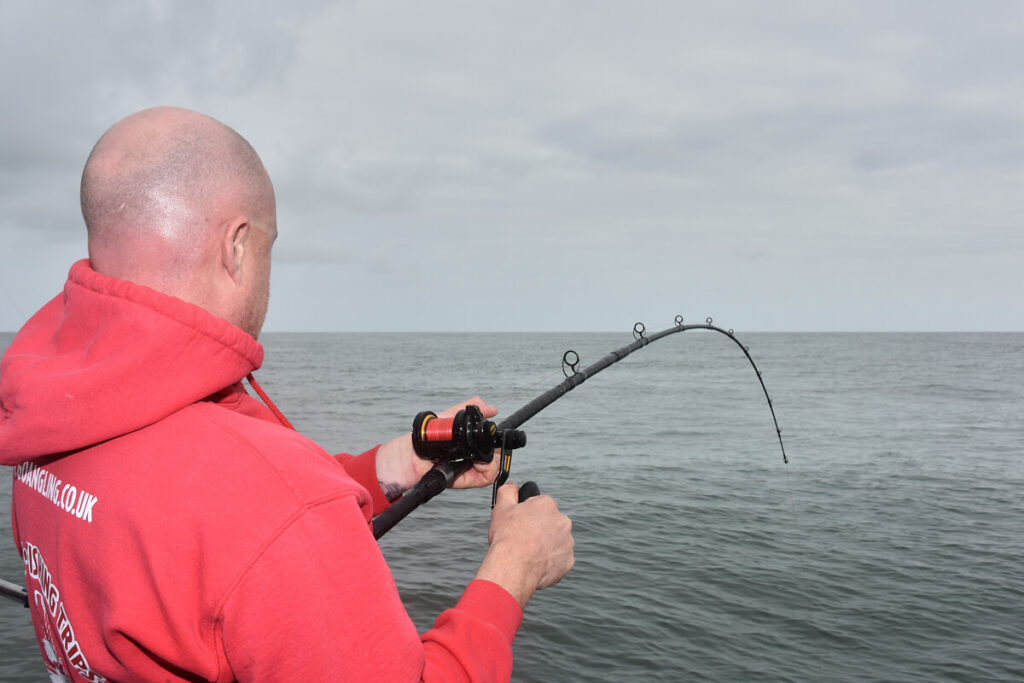
In both cases, the TSF team likes to use a shock leader. We prefer Fluorocarbon for its abrasion resistance and the limited stretch works in unison with the near non-stretch braid. Alternatively, a mono leader works too. These need to be about twice the length of the rod or a bit longer, just enough to have a few turns of shock leader on the reel spool with the fish at the boat side on the surface. The leader is necessary because a spurdog will twist and turn as it fights. This can see the line wrap around the body or come in contact with the spines on the dorsals or even the teeth in the mouth. Anyone who’s tried to cut through fluorocarbon with their own teeth will realise just how tough this material is, hence our preference for it.
You’ll need to carry a range of lead weight sizes with you. Good ones to have are 6oz, 8oz, 10oz, 12oz and 1lb. There may be times in some areas where the peak flow, or boat drift speed requires heavier leads than this to be used. But the attributes of modern braid lines being so thin in diameter means that lighter leads can be used but still stay in contact with the seabed. In our experience, the leads suggested, when using braid lines, will cover 90% of spurdog fishing.
2-Hook Spurdog Muppet Rig
Use a minimum of 130lb mono for spurdog traces as these fish have very sharp teeth and can easily cut through lighter breaking strains. Better still, use heavy fluorocarbon of 100lb breaking strain as this is much harder for the fish to chew through.
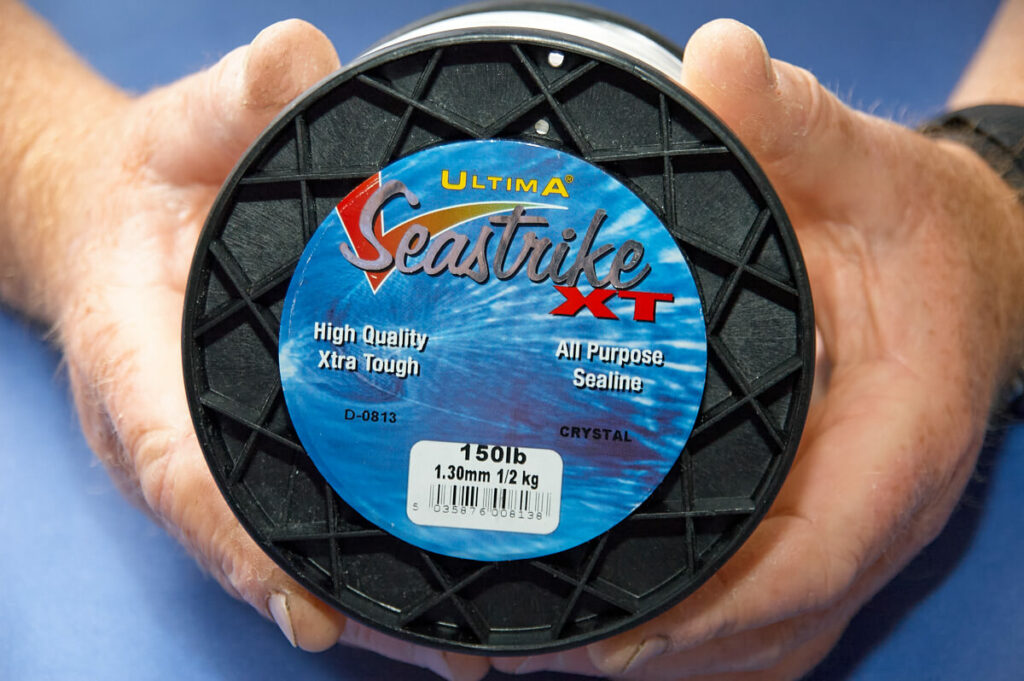
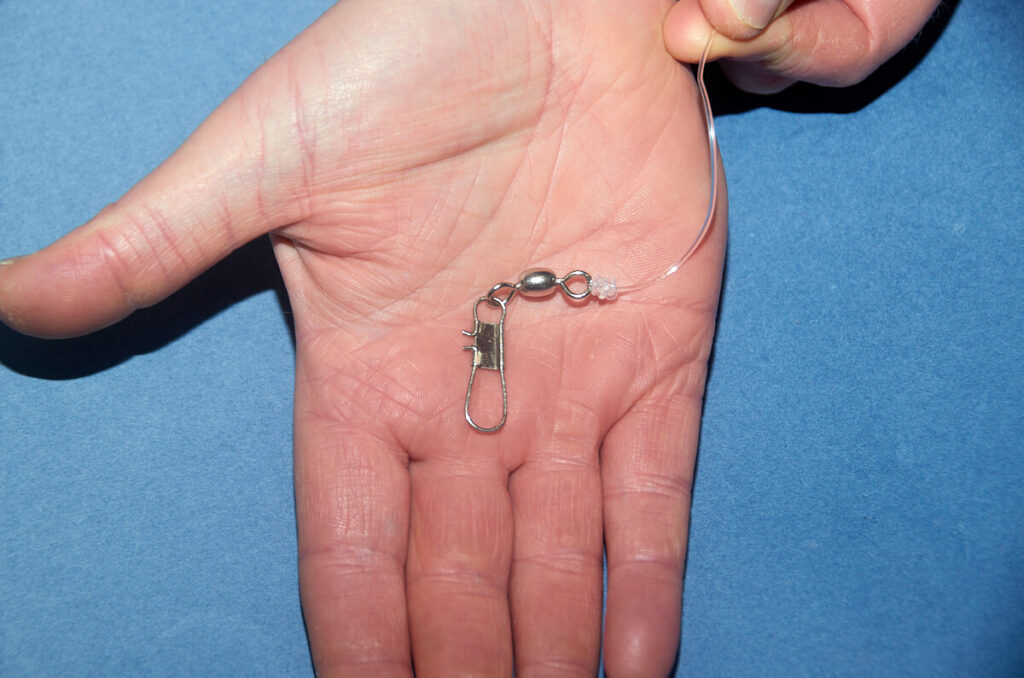
2. At one end tie on a size 2/0 snap link swivel to take the lead weight.
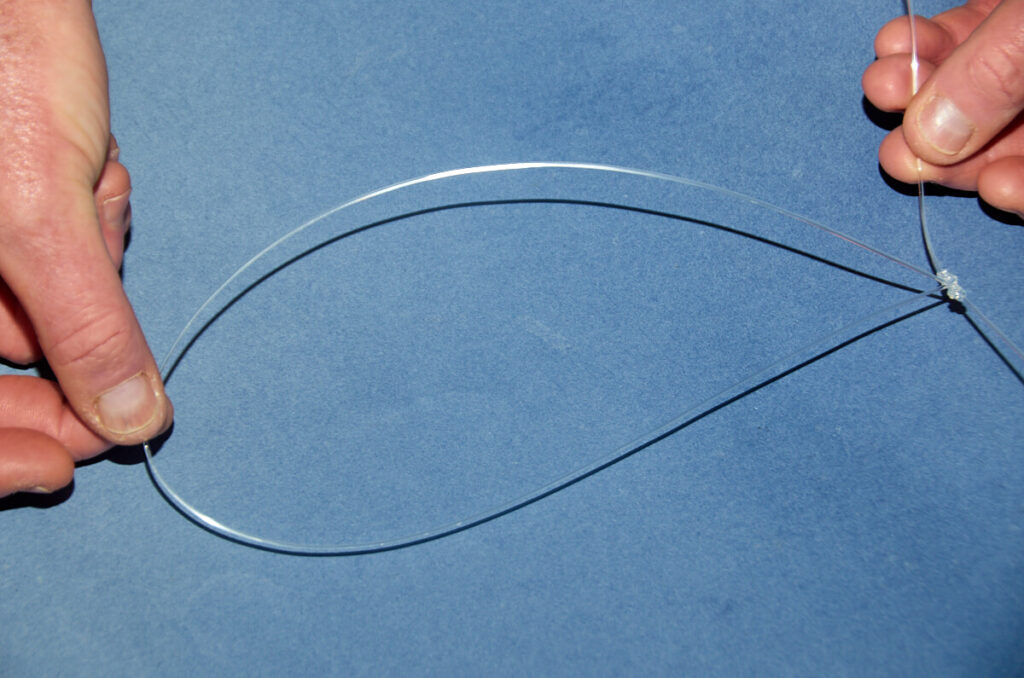
3. 2-feet above the snap link swivel, tie in a 10-inch stand-off loop using an 8-turn blood loop knot.
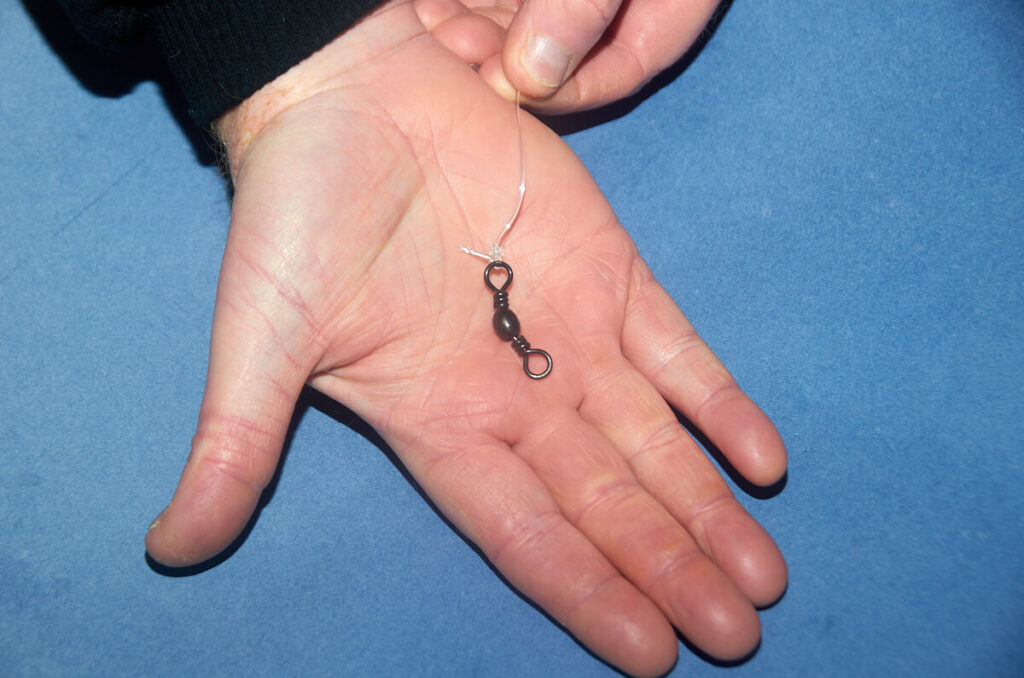
4. 3-feet above this tie in another 10-inch blood loop.
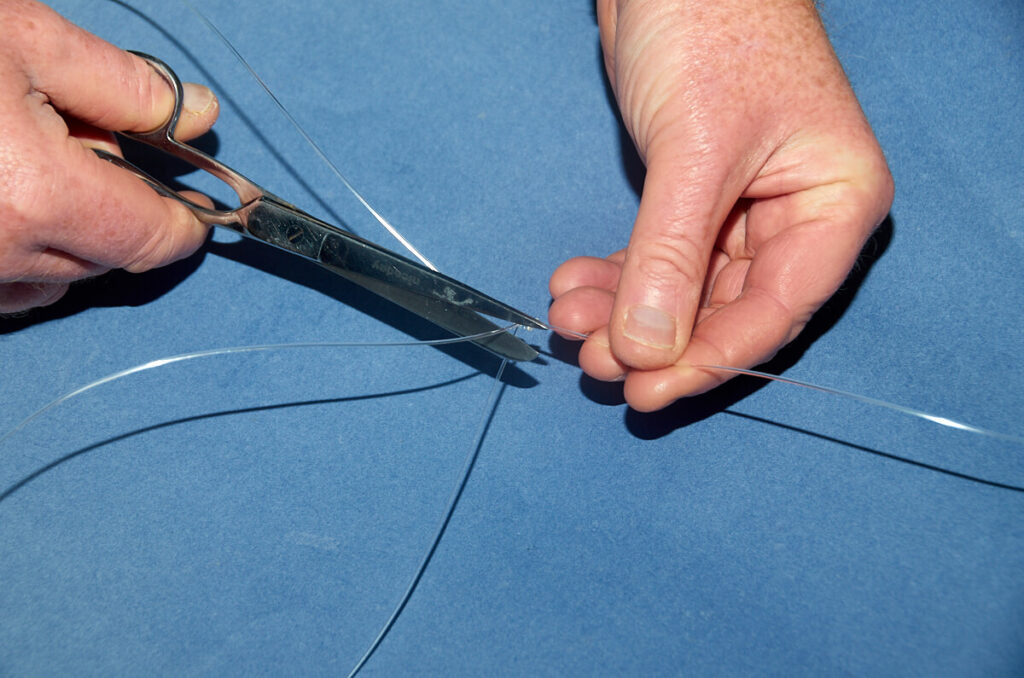
5. To the free end of mono tie on a size 2/0 swivel.
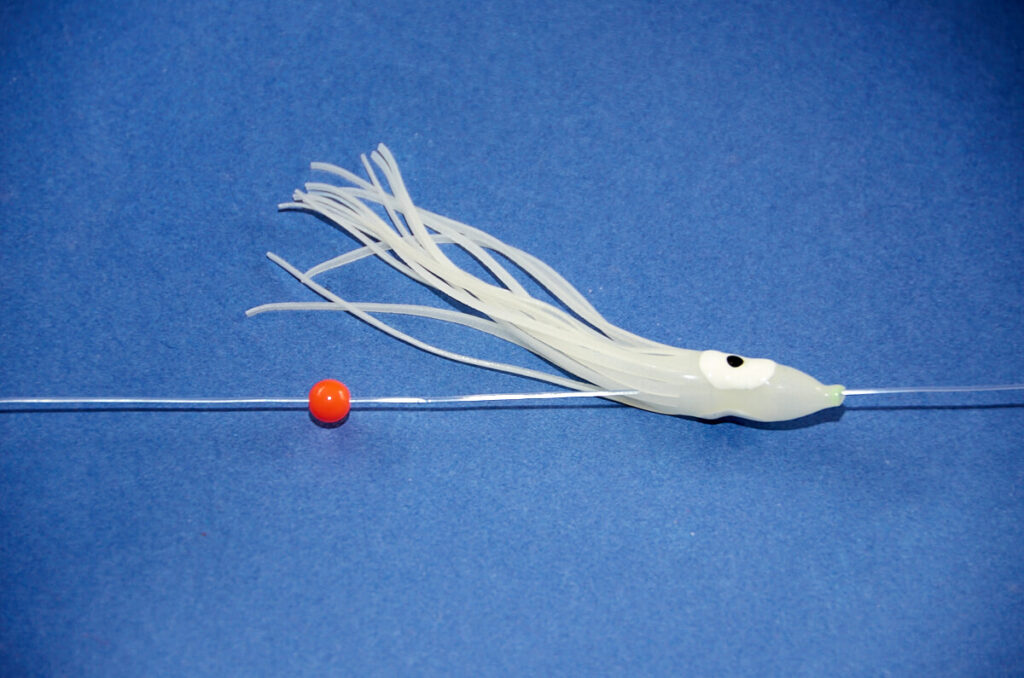
6. Cut the blood loops once near to the rig body knot to form a single hook length.
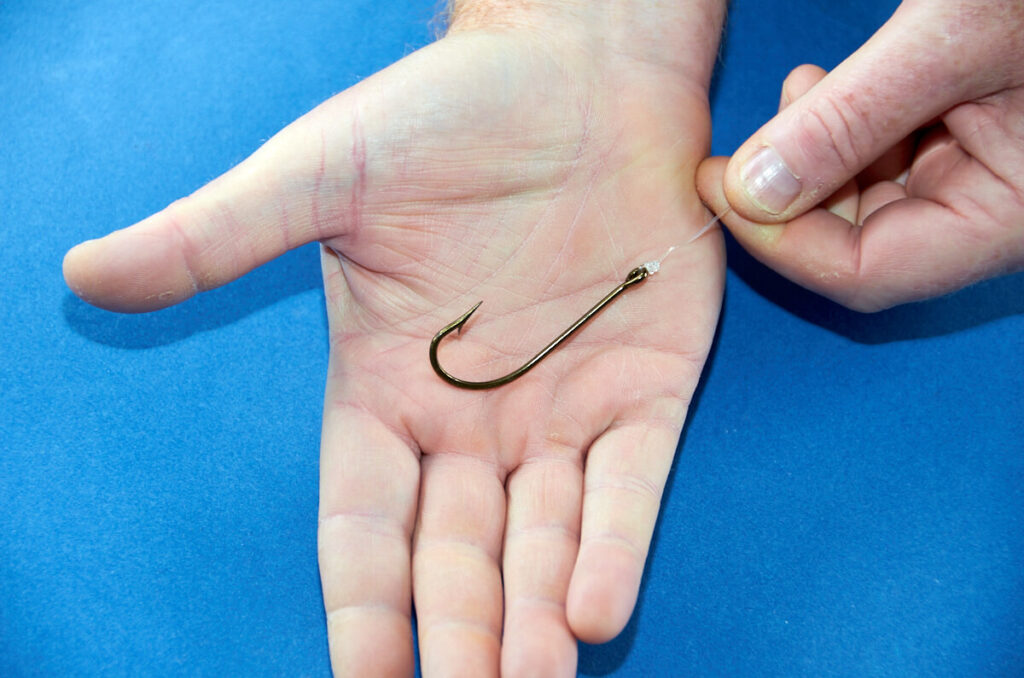
7. Finish each hook snood with a size 8/0 O’Shaughnessy pattern hook.
If you’re fishing an area where very big spurdog in the high teens are possible, then it can be an advantage to modify the hook lengths on this rig. Form the hook length loops as before and cut the loop once by the knot to form the hook length. This needs to be about 8ins long with a strong link attached, either a swivel link or a Gemini lead link. Instead of using either mono or fluorocarbon to the hook, make short 6-inch 50lb wire hook lengths, one end with a crimped on swivel, then slide on the muppet or lumo tubing, then crimp on an 8/0 O’Shaughnessy. The swivel then can be clipped onto the link. You can make up a few wire traces so you can easily change any that become twisted or damaged, plus the wire is near impossible for even the biggest spur to bite through, though they can make a mess of these traces too.
The best wire is multi-strand which retains some suppleness. The plastic coated wire is ok, but you’ll find the plastic coating is easily torn off when fighting a spur and it encourages the wire to twist and contort.
Add bait to the hooks and then slide the muppet down over the bait. The legs of the muppet add movement and colour for added effectiveness at depth.
The best colours for muppets are pink or red, but especially luminous green. Before sending a luminous muppet down to the depths, charging fully with a light will make the muppet brighter and more attractive. Tronixpro sell a UV Light especially for this job but a camera flash or phone light works too. Alternatively, add a short 2.5-inch section of luminous pink or yellow tubing above the hook, which works almost as effectively.
Size wise, the standard 3in to 5in muppets are plenty big enough giving movement and a sight target.
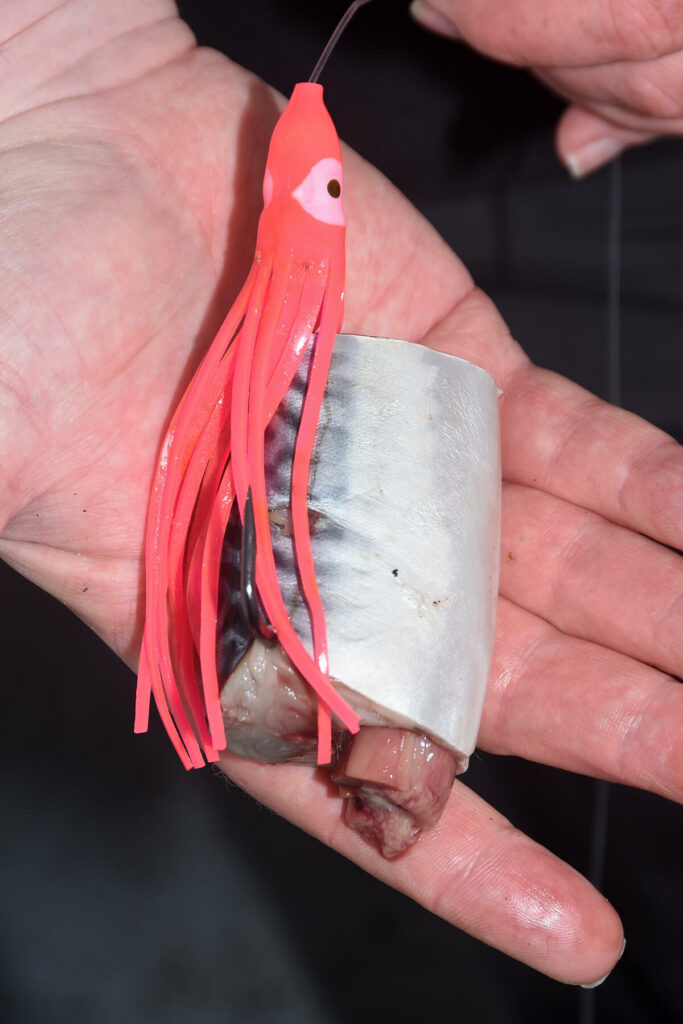
These are made on heavier 60lb to 80lb mono for the commercial fishing market and prove very adept at catching spurs when baited with mackerel, herring or squid. The feathers come in colours or all white. Go for the all-white every time! These imitate a shoal of small fish, plus with the added scent from the baits, it will draw the spurs in who are predators and looking for easy meals.
Because the feathers are being worked up and down in the water by lifting and lowering the rod tip, the spurs are less likely to take the feathers and bait fully in the mouth, usually getting hooked in the upper jaw or scissors. This means their teeth do not come in contact with the mono too often, so you’ll land the majority of fish you hook. It’s worth sharpening the hooks properly before you fish as these feather hooks are big and heavy wired and tend to come quite blunt.
Spurdog, as we’ve seen, are very predatory, so a baited chrome bar pirk is effective for them and especially so for the bigger fish in the shoal. The best bought pirks are the Solvkroken ones that have a bent shape. These pull upwards in a straight line, but when released flutter back to the seabed in an unpredicted way and imitate a dying or wounded fish. Bait the hook with a small fillet of mackerel or herring for added effectiveness.
Another edge when using a bar pirk is to add a very short length of lumo tubing to the hook shank before adding the hook to the pirk. This, along with the bait, draws the spurdog to the hook end.
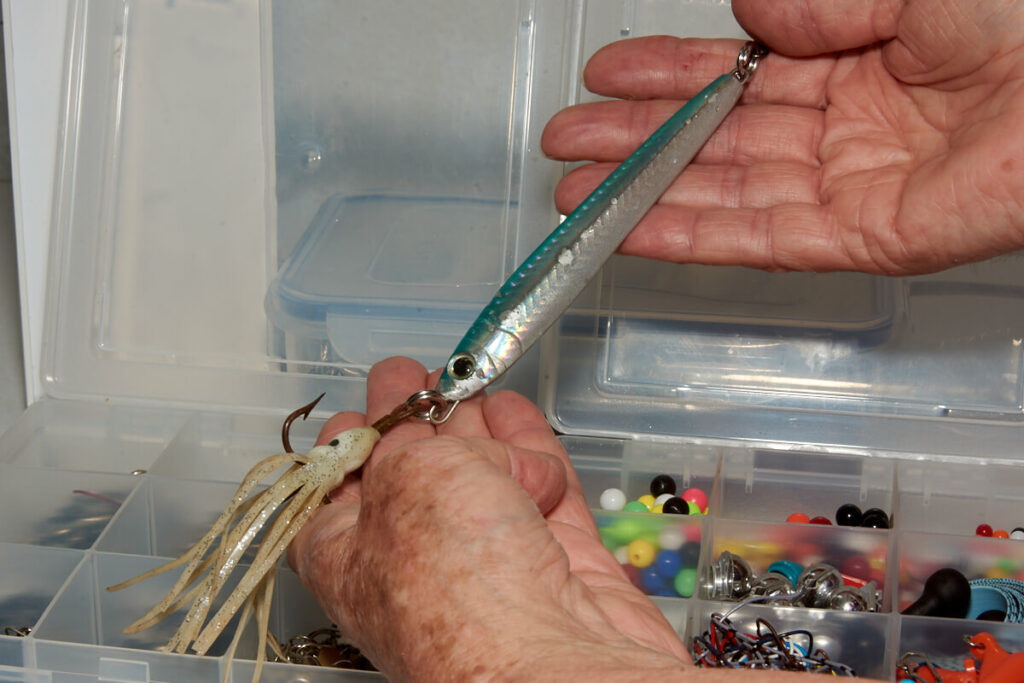
Some anglers, especially in Scotland, favour longer single hook flowing traces for spurdogs, but these are prone to tangling on the way to the seabed, and when fishing over rougher mixed ground can often snag. The muppets and the feathers do the same job, but without the tangles and limit the chance of snagging.
Early in the season from February to April the best bait, if you can get it, is fresh herring. This is normally what the spurdogs are feeding on in many areas and it pays to give them what they expect to eat. By mid- May and right through to October mackerel is the number one bait, with herring coming back into focus over the Christmas and New Year period.
Both herring and mackerel should be cut into 3-inch square sections off the fillet. Spurdog are killers and biters, they are not impressed by neatly cut baits. They are only interested in the scent, so simply pass the hook point once through the skin side, then bring the point back through from the flesh side. Be prepared to change baits frequently to keep the scent fresh.
Spurdog will also take bluey cut the same way as mackerel and herring, also chunks of squid. If you’re struggling for fresh bait, frozen mackerel and herring will work, but a better bet is to catch some fresh whiting off the bottom and use fillet sections of these. If mackerel and herring are scarce, the spurs are likely to be feeding hard on the bottom and taking mainly whiting, anyway.
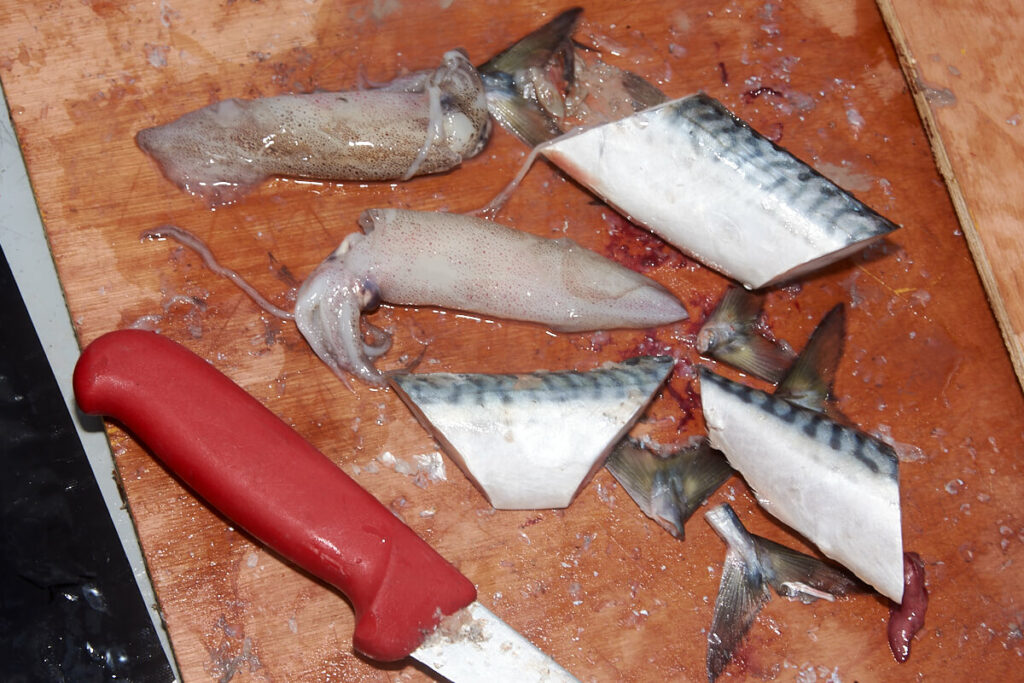
It’s important when fishing the bottom to make sure you are using a lead weight heavy enough to keep in contact with the seabed. If the line is streaming off downtide or away from the drift of the boat, then you’re unlikely to be in the feeding zone. Aim to have enough lead on to keep that contact, but only use as much as you need to achieve that. Using overly heavy leads will tire you quicker when working the rigs, plus make it harder work retrieving tackle from greater depths.
Using the muppet rig, the feathers, and the pirk are pretty much all the same technique. It requires you to touch the seabed with the lead weight, then retrieve no more than 4ft of line. By using the rod tip to then lift and lower the rigs and pirk up and down just off the seabed this imitates that small shoal of fish and will quickly draw the spurs in who “feel” the movement of the muppets and rigs, see the luminous effect in the water, and smell the scent of the cut baits. A simple effective recipe for success.
Obviously, the same up and down technique is used when the fish are up in the water column. However, take note where the bites start to occur then count how long it takes for the tackle to reach a depth where the fish are then you can concentrate on that depth each time you drop to maximise your fishing time.
Bites are simple to decipher. The spur basically charges in and grabs what it feels and sees or smells. A typical spur bite is a sudden weight on the rod tip and the tip pulling hard over to the weight of the fish which sets the hook. They use their weight during the fight, often go round in small circles, and jag the rod tip down hard. Bigger spurs will try and run, but few take a lot of line.
[*]When fishing the muppets or the feathers near the seabed or up in the water column, change the lead weight for the bar pirk. The pirk adds flash and movement when the rig is worked and helps increase the attraction of the rig. It’s interesting too, that often when fishing this method, that the bigger spurs take the pirk making your fishing more selective.[*]Using luminous lead weights can also increase your catch rate. The luminous yellow, orange and white coated leads are all good on the day, but the orange can be especially effective. It pays to change the colours around as conditions during the day change as this can make a real difference. One to look out for is that in low light levels the yellow and white are good, but as the sun moves higher in the sky and more light passes down through the water column the orange can be the better colour. [*]On the way out to the fishing grounds, take the time to cut up some spare bait and place this in a plastic sealed container to stay fresh, but do keep it cool. This means while fishing you are not wasting time cutting up bait before each drop. Spurdog fishing can be frantic for an hour or two, then suddenly stop, so maximising your fishing time can be vital.[*]In the same vein, when using the clip on wire traces, have a few of these ready baited and stored in the plastic box to keep fresh. It’s then just a case of unclipping a trace with used bait on and clipping on a new one ready to go. This rapid change round of baits can literally double your catch in the time spent fishing. [/list]
Being able to fish spurdogs off the shore consistently is not available to many. In the UK it is confined mainly to the west coast of Scotland in the deeper saltwater lochs, off Orkney, and in selected spots along the west coast of Ireland such as the Kerry coast, also Galway and Donegal. They may appear briefly in a few other areas but cannot be called common.
Interestingly, spurdog will run the steep-to beaches along the southern coast of Iceland, but very few adapt this habit in UK and Irish waters.
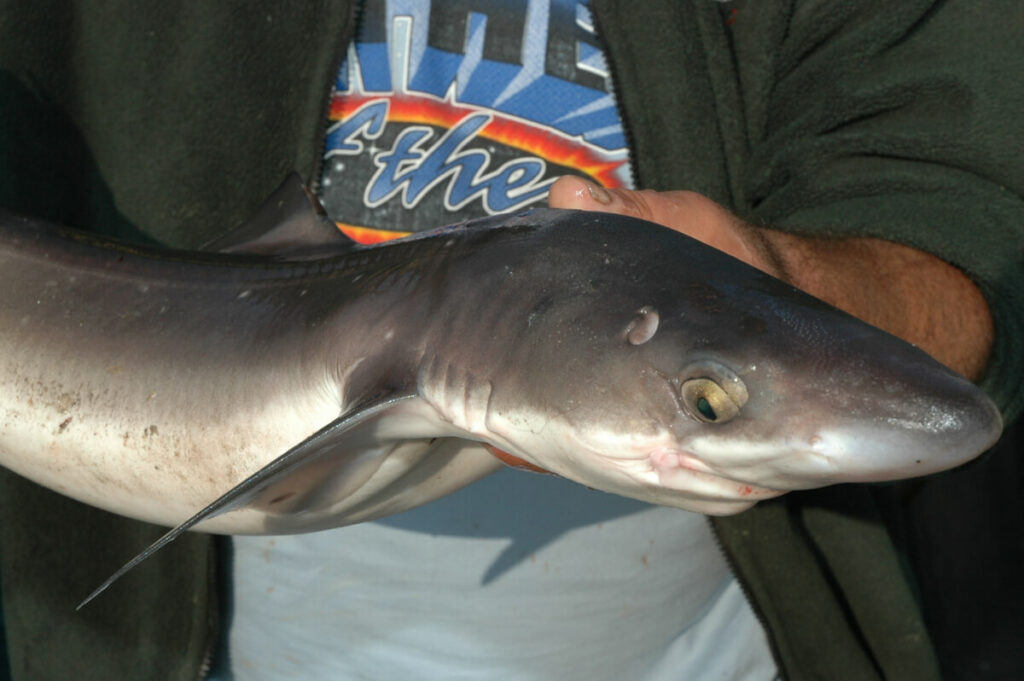
Off the shore, it tends to be the bigger tides that produce the best fishing for as we know the spurs like a little run in the water. That said, depth is more important which is why the more prolific Scottish sea lochs can fish so well having immediate access to water over 100-feet deep virtually right at your feet. Neap tides will also produce, especially in the deeper estuaries where the spurs come for short periods and this is evident off the Kerry, Galway and Donegal coast in Ireland.
During the neap tides, expect the best fishing to be through the middle hours of the flooding tide with fewer fish evident on the ebbing tide. On bigger spring tides the feeding time is likely to be shorter. Typically, for the second and 5th hour of the flood tide. The middle hours of peak flow in some areas being too quick for the spurs to be within casting range. In some areas, due to this effect, the ebbing tide can fish better if the flow of the tide is slower. Obviously, all this is a generalisation intended as a guide. Marks that give access to shore spurdog ideally need to be learned and read as individual marks due to their unusual nature with the deeper water.
The spurdog will be drawn in tight to shore by the influx of bait fish such as mackerel and herring. In rougher weather periods, the baitfish will be at range and not within casting distance. So, what we’re looking for, are longer periods of relatively settled weather patterns with calmer seas, just the conditions that see baitfish drawn inshore and right up to the cliff edges.
You can catch spurs by day off the shore in very deep water, but generally you’ll do better in the dark hours. Also, try to fish a tide that starts to flood in the dark and with high water in the dark. These conditions will fish the best. By day, avoid bright sunny days and choose overcast even gloomy days for the best results.
Spurs, on certain marks, can be landed for much of the year, but more likely they will be more predictable for relatively short periods. The early spring March and April can be good, but the best time generally is from September to early December. If you look into when the herring are most prolific in your areas, then this will be a good guideline to work too.
Fishing off the shore is about strong tackle. In shallower water a smaller Penn 525 Mag reel might do, but ideally you need more cranking power and more line capacity. It’s no longer made, but one of the most popular reels for deep water shore fishing due to its casting ability for its size and the power of its gearing was the Penn 535. If you can find one of these reels, then they are well up to the job, otherwise look at alternative Shimano and Daiwa models, or maybe the Penn Fathom 30 reel which does cast fairly well and has the line capacity needed.
Load the reels with a minimum of 20lb mono, though 25lb would be better and add a 60lb shock leader.
Rods need to be powerful 6oz beachcasters about 13ft in length. This length helps manoeuvre fish when they are close into the rocks.
Some anglers choose powerful 14ft Euro style rods with bigger 8000 fixed spool reels with conventional deep spools loaded with 50 to 60lb braid and dispense with the shock leader.
Make sure you use a good sturdy rod rest and make sure it is anchored to the ground by a couple of lanyards because even a modest spurdog will hammer the rod tip over and try to take the rod and rest with it.
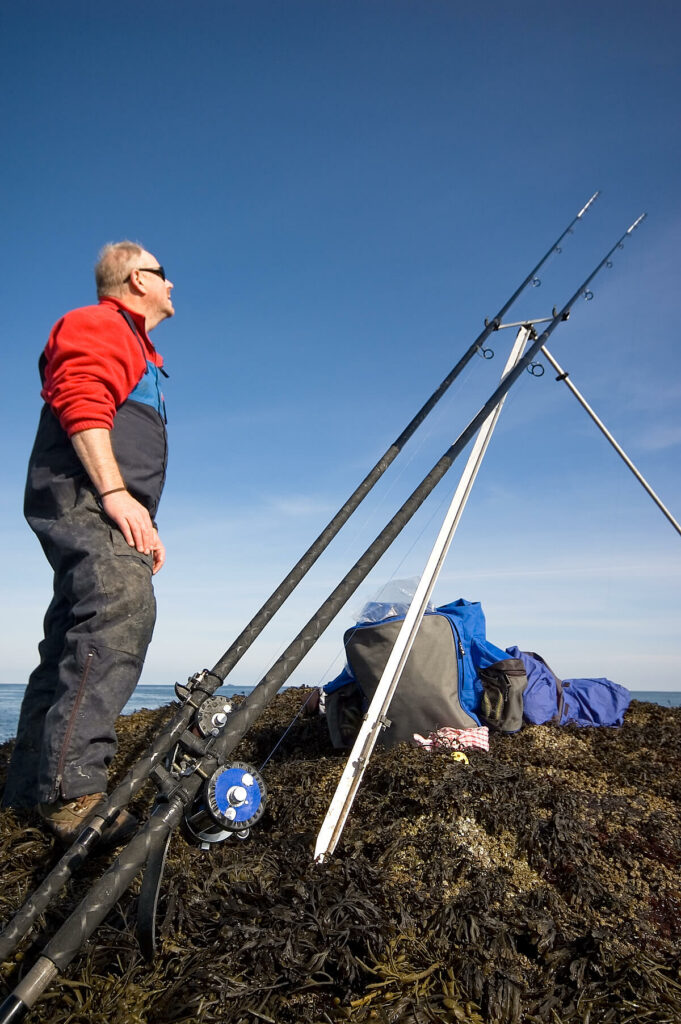
As for rigs, keep it simple to limit tangles and facilitate long range casting. The best is a pulley rig.
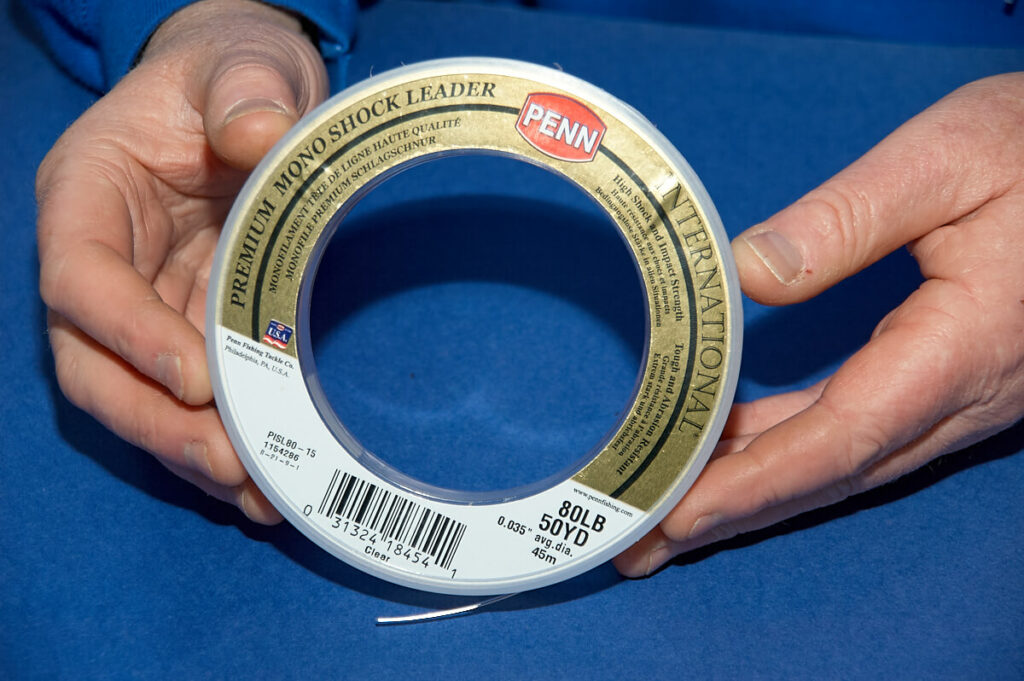
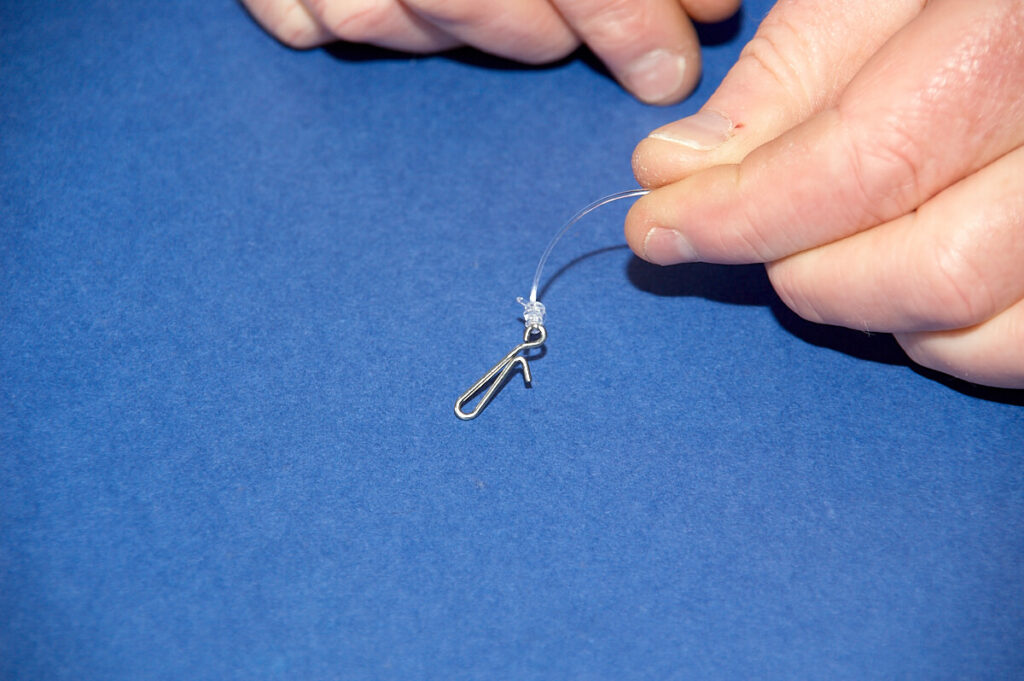
2. At one end tie on a Gemini Bait/Lead Clip.
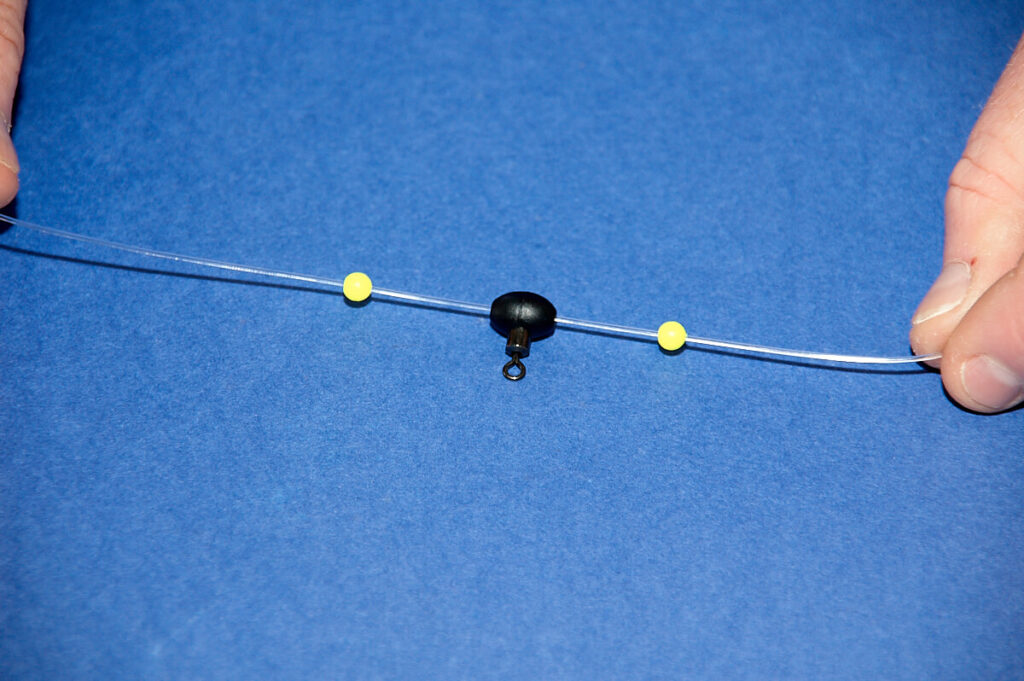
3. Slide on a 5mm rig bead, a pulley rig bead and another 5mm rig bead.
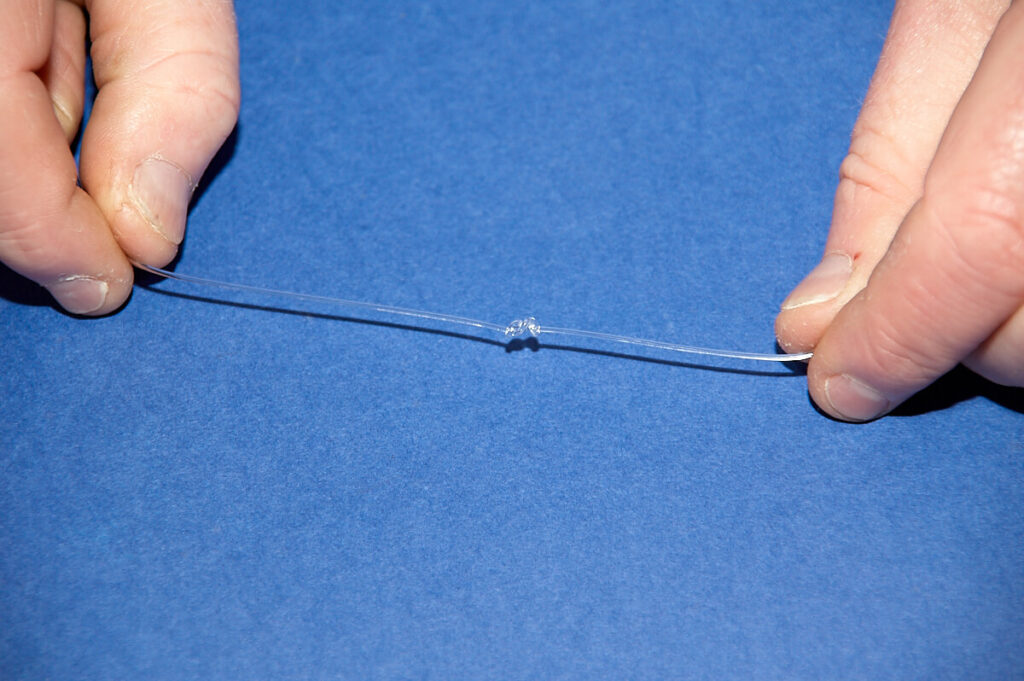
4. Leaving a good 24-inches of free end to form the hook snood tie in a figure of eight knot. There is no weight when casting on this knot and it is perfectly strong for fighting big fish.
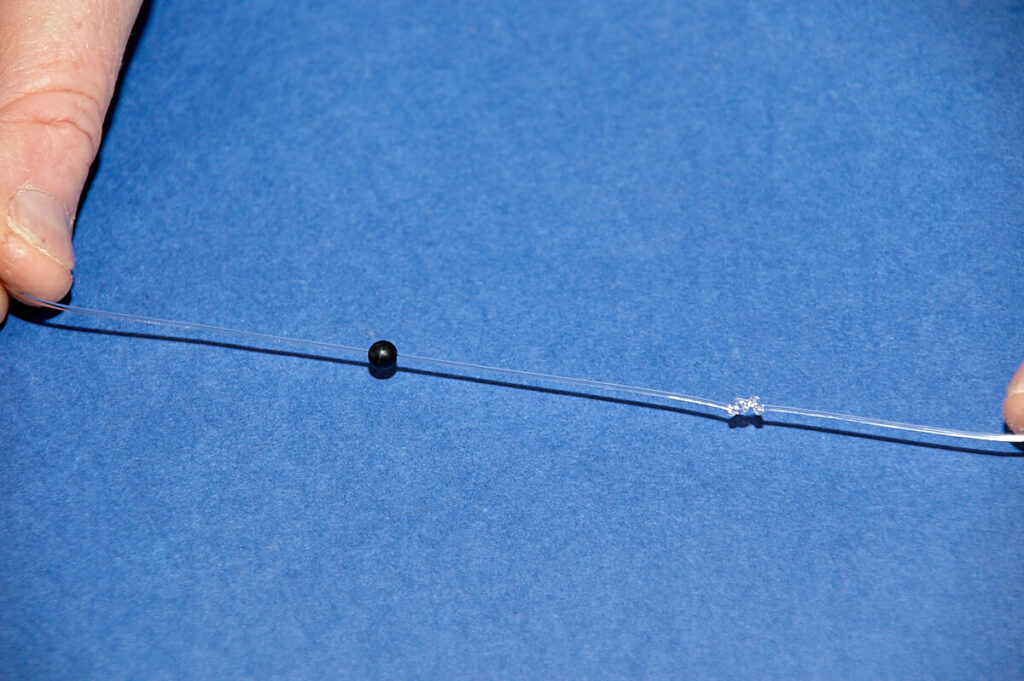
5. On the free end forming the hook length slide on an 8mm rig bead.
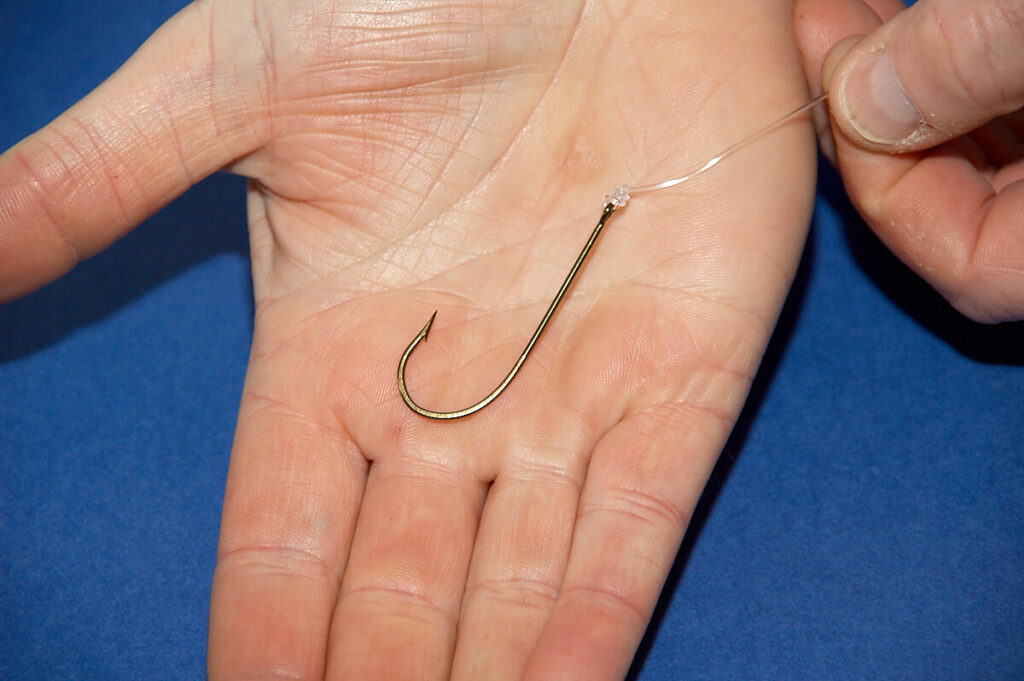
6. Tie on a Mustad 79515 Uptide hook size 6/0.
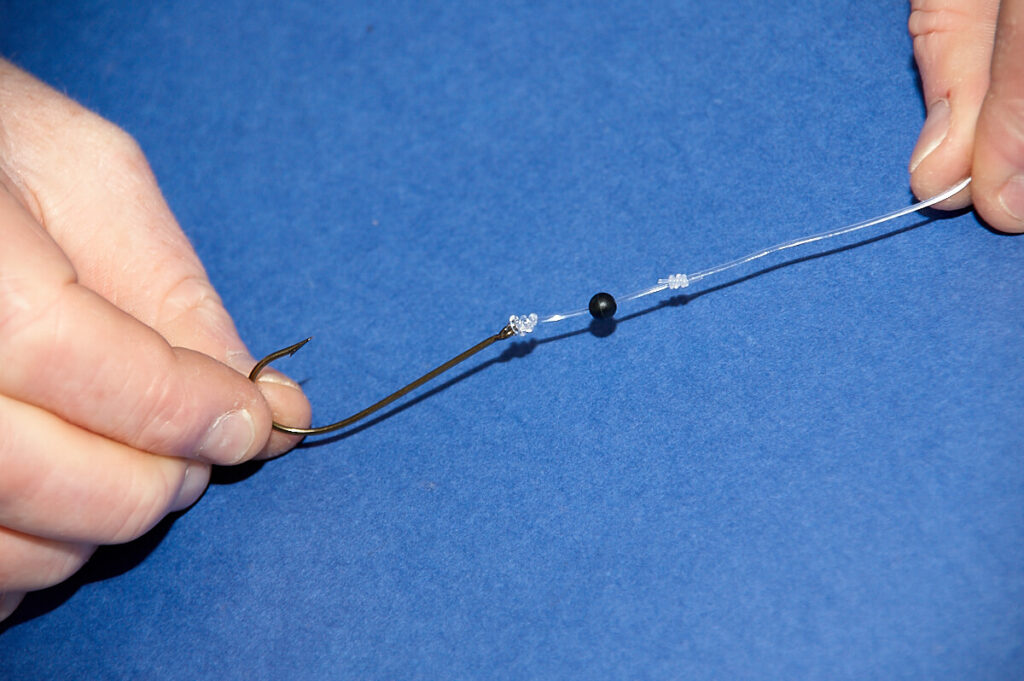
7. Above the bead positioned above the hook tie on a Powergum sliding stop knot to act as a bait stop.
The baited hook goes in the lead clip clip for casting making the rig streamlined but with instant release on hitting the water. The pulley rig is perfect because when a fish takes the bait and pulls tight to the lead weight, this will mostly self-hook the fish. Also, the pulley effect of this rig will pull the lead weight up to the Pulley Rig Bead keeping the weight well up in the water and away from snags while playing the fish.
You only need one hook. Spurs are greedy fish and will gulp in the whole bait and hook easily enough. 2-hook pennel rigs just snag more easily when fishing rough ground and hauling fish through kelp weed beds, plus baits do not need to be overly big.
Again, if you want to use short sections of 50lb wire to combat the spurs teeth, then leave the tag end of line below the figure-of eight-knot at just 18-inches and tie on a Gemini Lead Clip. Cut the wire at about 6-inches in length and at one end crimp on a size 2 swivel, and to the other slide on any beads or tubing, then crimp on a size 6/0 Viking hook. You can also make up a few extra hook lengths for pre-baiting or changing and they simply clip on and off the Gemini link as needed.
Stick to four baits, mackerel, herring, bluey and squid in that order, for all your shore fishing.
The mackerel and herring can be cut into sections off the fillet about 4ins long and maybe an inch wide or a little bigger leaving plenty of flesh on the bait. Pass the hook through one end from the skin side, pull the hook through then bring the point back out from the flesh side to the skin side to leave the point well clear, then add a few wraps of bait elastic to secure the bait for casting. You’re looking to create a sausage shaped bait. If you need to bulk the bait out, add another thinner sliver of mackerel on the back of the hook shank and add more bait elastic.
Bluey can be cut into whole body sections about 3 to 4ins long, no more. Pass the hook in through one end and out through the base, then bind with bait elastic.
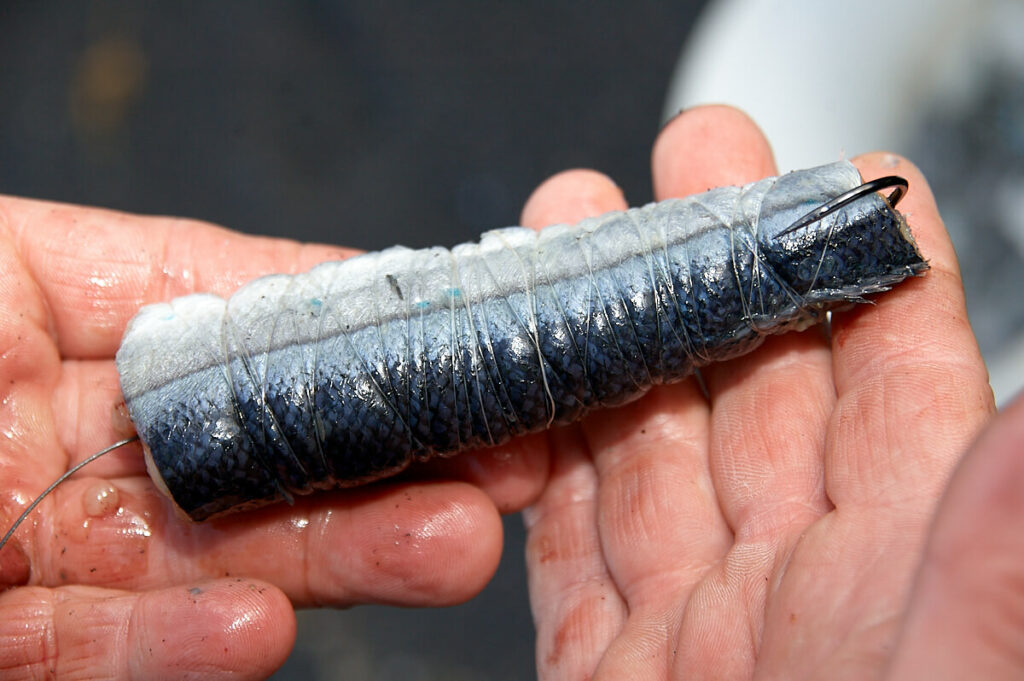
Squid can be used either whole for small ones, or in halves for bigger ones. Again, pass the hook point through one end, bring it through, then out at the base. Also fold the head back under the bait at the back and secure it all with bait elastic. Make sure the bait is secure and compact. Spurs, like conger and rays, will nip the head off and maybe leave the main bait if the head is left hanging free.
Spurs also like combination baits of herring or mackerel with squid, or mackerel or herring with a slice of bluey bound to the back of the main bait. The bluey is especially oily and keeps the scent trail flowing for much longer as it washes out much more slowly than mackerel or herring will.
One last point on bait size. Do not use oversize baits. It will result in dropped bites. Baits around 3ins or so in length are plenty big enough for spurs, even big ones, and allows the fish to quickly gulp them in. If the bait is too big the spur will try and carry the bait off but will often miss the hook. Smaller compact baits will also cast further and present the hook better.
It’s a simple way of fishing but aim to try and find where there is some holding feature on the seabed, this being a patch of rougher ground that butts up to a clean sandy or muddy bottom, or maybe a kelp weed bed.
Use heavier grip wired leads to hold bottom and after casting, fish to a slightly slack line when fishing into very deep water. You only need to release a couple of feet of line to form a slight droop in the line, but this ensures that the bait sits on the seabed. When a spurdog takes the slack line will quickly be taken up and the fish will possibly knock on the rod tip a couple of times as it takes the bait, but then the rod tip will pull hard over as it tries to make off with its meal. Remember, spurs are pack or shoal fish and will have competitors very close to them, hence the savagery of the bite.
They will fight grudgingly up through the water column twisting and turning in the tide, often in short circles. Just keep them coming. They can dive when on the surface, but rarely take too much line.
[*]Again, you can add a short length of luminous tubing above the hook, or even the addition of a three or four larger 8mm luminous beads can work well, too. Do charge the tubing or the beads with a headlight, mobile phone light or a dedicated UV light.[*]When fishing at night, using a coloured shock leader such as yellow that is easily seen via your headlight, enables you to see when the spurdog hits the surface and where it is situated regards landing it.[*]When fishing off the shore, be it a grassy bank or more likely a rock ledge, decide before you fish where exactly it is safe to land a fish. This needs to be confirmed with your fishing buddy before fishing. You do not want to be thinking about where might be best to land fish in the dark with a big lively spur on the surface just in front of you.[/list]
Spurdog are a member of the shark family and were loathed as a pest and nuisance fish by commercial fishermen in the 19th century and first half of the 20th century for the damage they caused to both their nets and to hooked fish caught on long-lines. They became more popular when a use for their liver oil was found. The liver of the spurdog is overly large for the size of the fish and was a valuable commodity for using in fish oil products, cosmetics, and health supplements. Spurdog flesh was also used to turn into fish meal. Spurdog have since been caught commercially for human food, the flesh often being marketed at the fishmongers and in the Fish & Chip shops as “flake”.
This sudden commercial popularity saw the spurdog stock numbers crash massively during the 1970’s and early 1980’s. In 2010 the European Union imposed a zero Total Allowable Catch limit stopping commercial fishermen from retaining any caught spurdog. Thankfully, although still classed as vulnerable in European waters, their numbers are slowly increasing again.
Spurdog identification
The spurdog is shark shaped, so physically looks a little like several other smaller British sharks, principally the tope and smoothhound. However, the spurdog is the only British and Irish Shark with a sharp spine situated on the front of both dorsal fins. These spines are large and obviously protrude well clear of the fin. The spines can inflict a serious wound and the bacteria on the spine can cause infections, so some care is needed when handling these fish.
The body shape is shark shaped but slim with a pointed snout, large eyes. The pectoral fins are roughly triangular and broad in shape. Spurs also lack an anal fin.
Its colouration is typically dark grey on the back with scattered light spots on the body, especially the flanks. The belly is a lighter grey. In very deep water the spurdogs back can be almost dark slate grey with a hint of blue.
Spurdog give birth to live young, gestation being long from 18 to 22 months and the litter ranging from 3 to 11 pups from 8 to 13-inches in length, the number and size being dependent on the size of the mother. Males are mature at about 22-inches in length and females around 30-inches.
They can grow to between 25lbs and 30lbs, but a specimen sized spur in most areas would be in the region of 12 to 13lbs currently, though fish in the high teens are not that uncommon given the improvement in overall stock levels over recent years.

Spurdog distribution
Spurdog are found throughout the Mediterranean and into the Black Sea, in the upper section of North Africa, all along the European coast, inside the North Sea and throughout Norway to just beyond the Russian border. They are also found around Iceland and down the east coast of America almost to Florida.
They are common all around the UK and Ireland with hotspots in the southwest approaches of the English Channel, inside the Bristol Channel, the Irish Sea and off the west coast of Scotland. They are also found all around Ireland with major concentrations in the Irish Sea, off the Cork and Kerry coast, Donegal, and Northern Ireland.
Spurdog habitat
Typically, spurdogs are found in depths from 40-feet to 600-feet but can be resident in much greater depths exceeding 2000-feet. They come shallower as light levels fall in the evening following up the smaller plankton feeding fish such as herring right up to the surface. They are found mainly over a soft sandy or muddy seabed, but also take up residence around deep water wrecks and reefs.
They form huge unisex schools of fish of different sizes and can wipe out food in a given area making them nomadic as they seek new feeding grounds. It’s this long gestation period and their large overall size before maturity is reached, that makes them vulnerable to overexploitation.
Spurdog diet
Their diet includes a range of small fish such as herring, mackerel, spart, sandeels, pilchards and garfish when feeding higher up in the water column, but cod, whiting, haddock, flatfish, dragonets and crabs when feeding near the bottom. They will also lift in the water column to intercept squid and octopus when they are plentiful.
Spurdog season
They can be caught all year round, especially in areas with access to very deep water. However, their numbers tend to concentrate in the spring and autumn periods with March to May and late September to early December being especially good in many areas.
Boat fishing for spurdog
Tides
As is so often the case when boat fishing, it’s the influence of the tides on the boat that governs the best tides for fishing. In most areas, due to fishing in water in excess of 150ft deep and being well offshore, then it’s the smaller neap tides that will usually be the best for fishing when the boat’s drift speed is lessened. On the bigger tides, the drift speed is likely to be too fast to keep the baits fully in the fishing zone.
Regarding the state of the tide, the spurs tend to go off the feed either side of slack water, both high and low, when there's little in the way of flow. However, at slack water, try fishing up in the water column say 20 to 40-feet above the seabed as the packs of spurs will sometimes lift off the seabed at this time to target food fish.
The best period is when the tide is flowing during the middle hours of the flooding tide, and again during the ebb tide. The spurs will be tight to the seabed at this time, certainly under 20-feet off the bottom. Even when the tide is flowing, the shoal may sit at roughly 2/3rds depth or even at mid depth if there are food fish available. It’s a case of finding out where they are feeding and then concentrating at that depth.
Weather patterns
Being deep water living mostly, they are not affected by weather patterns too much. Even so they will, after prolonged periods of rough seas with a heavy swell, move out into water in excess of 25-feet, but quickly come back in again. This is probably more to do with the outward migration of food fish at this time than their inability to handle rougher seas.
Ideal conditions for spurs, even in deep water, are relatively light seas with a little swell that makes the baits jig up and down off the seabed. Cloudy days are better than bright sunny days when light levels are high. They will also tend to be caught in better numbers when the angle of the sun is lower during the day, so typically early morning and late afternoon.
If you can hit the spur grounds a couple of tides before a big blow moves in, in the autumn, then the incoming low pressure can induce some serious feeding and big catches can be made. The opposite is true if you venture out a couple of days after a prolonged gale as the sea settles, it takes time for the food fish and the spurs to move back in, especially in water under 200-feet deep.
Tackle
Due to the depths you’re likely to be fishing, and the average size of fish likely, robust tackle needs to be chosen. Standard boat rods in the 20/30lb class will suit most situations allied to a multiplier, either a star drag or lever drag, and holding 300-yards of 30lb braid, plus some mono backing are ideal. In shallower water (up to 150-feet) and lighter tides a straight 20lb class rod is perfect, but in deeper water and when the boat drift is faster requiring heavier leads, then the 30lb is the better choice. Length needs to be 7ft 6in or slightly longer.
Although there are not many about, some modern rods for braid are rated as 20/40lb class and these are as good as it gets for spurdog fishing having the sensitivity in the tip and upper mid-section to give maximum sport with average spurs, but with power in the lower mid-section and a stiff butt providing real lifting power when bigger fish are hooked at depth. That same reel, again with 30lb braid, makes the ideal outfit.

In both cases, the TSF team likes to use a shock leader. We prefer Fluorocarbon for its abrasion resistance and the limited stretch works in unison with the near non-stretch braid. Alternatively, a mono leader works too. These need to be about twice the length of the rod or a bit longer, just enough to have a few turns of shock leader on the reel spool with the fish at the boat side on the surface. The leader is necessary because a spurdog will twist and turn as it fights. This can see the line wrap around the body or come in contact with the spines on the dorsals or even the teeth in the mouth. Anyone who’s tried to cut through fluorocarbon with their own teeth will realise just how tough this material is, hence our preference for it.
You’ll need to carry a range of lead weight sizes with you. Good ones to have are 6oz, 8oz, 10oz, 12oz and 1lb. There may be times in some areas where the peak flow, or boat drift speed requires heavier leads than this to be used. But the attributes of modern braid lines being so thin in diameter means that lighter leads can be used but still stay in contact with the seabed. In our experience, the leads suggested, when using braid lines, will cover 90% of spurdog fishing.
Rigs
2-Hook Spurdog Muppet Rig
Use a minimum of 130lb mono for spurdog traces as these fish have very sharp teeth and can easily cut through lighter breaking strains. Better still, use heavy fluorocarbon of 100lb breaking strain as this is much harder for the fish to chew through.

- Begin with 10-feet of 130lb to 200lb clear mono.

2. At one end tie on a size 2/0 snap link swivel to take the lead weight.

3. 2-feet above the snap link swivel, tie in a 10-inch stand-off loop using an 8-turn blood loop knot.

4. 3-feet above this tie in another 10-inch blood loop.

5. To the free end of mono tie on a size 2/0 swivel.

6. Cut the blood loops once near to the rig body knot to form a single hook length.

7. Finish each hook snood with a size 8/0 O’Shaughnessy pattern hook.
Wire hook lengths
If you’re fishing an area where very big spurdog in the high teens are possible, then it can be an advantage to modify the hook lengths on this rig. Form the hook length loops as before and cut the loop once by the knot to form the hook length. This needs to be about 8ins long with a strong link attached, either a swivel link or a Gemini lead link. Instead of using either mono or fluorocarbon to the hook, make short 6-inch 50lb wire hook lengths, one end with a crimped on swivel, then slide on the muppet or lumo tubing, then crimp on an 8/0 O’Shaughnessy. The swivel then can be clipped onto the link. You can make up a few wire traces so you can easily change any that become twisted or damaged, plus the wire is near impossible for even the biggest spur to bite through, though they can make a mess of these traces too.
The best wire is multi-strand which retains some suppleness. The plastic coated wire is ok, but you’ll find the plastic coating is easily torn off when fighting a spur and it encourages the wire to twist and contort.
Muppets
Add bait to the hooks and then slide the muppet down over the bait. The legs of the muppet add movement and colour for added effectiveness at depth.
The best colours for muppets are pink or red, but especially luminous green. Before sending a luminous muppet down to the depths, charging fully with a light will make the muppet brighter and more attractive. Tronixpro sell a UV Light especially for this job but a camera flash or phone light works too. Alternatively, add a short 2.5-inch section of luminous pink or yellow tubing above the hook, which works almost as effectively.
Size wise, the standard 3in to 5in muppets are plenty big enough giving movement and a sight target.

Commercial Cod Feathers
These are made on heavier 60lb to 80lb mono for the commercial fishing market and prove very adept at catching spurs when baited with mackerel, herring or squid. The feathers come in colours or all white. Go for the all-white every time! These imitate a shoal of small fish, plus with the added scent from the baits, it will draw the spurs in who are predators and looking for easy meals.
Because the feathers are being worked up and down in the water by lifting and lowering the rod tip, the spurs are less likely to take the feathers and bait fully in the mouth, usually getting hooked in the upper jaw or scissors. This means their teeth do not come in contact with the mono too often, so you’ll land the majority of fish you hook. It’s worth sharpening the hooks properly before you fish as these feather hooks are big and heavy wired and tend to come quite blunt.
Pirks
Spurdog, as we’ve seen, are very predatory, so a baited chrome bar pirk is effective for them and especially so for the bigger fish in the shoal. The best bought pirks are the Solvkroken ones that have a bent shape. These pull upwards in a straight line, but when released flutter back to the seabed in an unpredicted way and imitate a dying or wounded fish. Bait the hook with a small fillet of mackerel or herring for added effectiveness.
Another edge when using a bar pirk is to add a very short length of lumo tubing to the hook shank before adding the hook to the pirk. This, along with the bait, draws the spurdog to the hook end.

Alternatives
Some anglers, especially in Scotland, favour longer single hook flowing traces for spurdogs, but these are prone to tangling on the way to the seabed, and when fishing over rougher mixed ground can often snag. The muppets and the feathers do the same job, but without the tangles and limit the chance of snagging.
Baits
Early in the season from February to April the best bait, if you can get it, is fresh herring. This is normally what the spurdogs are feeding on in many areas and it pays to give them what they expect to eat. By mid- May and right through to October mackerel is the number one bait, with herring coming back into focus over the Christmas and New Year period.
Both herring and mackerel should be cut into 3-inch square sections off the fillet. Spurdog are killers and biters, they are not impressed by neatly cut baits. They are only interested in the scent, so simply pass the hook point once through the skin side, then bring the point back through from the flesh side. Be prepared to change baits frequently to keep the scent fresh.
Spurdog will also take bluey cut the same way as mackerel and herring, also chunks of squid. If you’re struggling for fresh bait, frozen mackerel and herring will work, but a better bet is to catch some fresh whiting off the bottom and use fillet sections of these. If mackerel and herring are scarce, the spurs are likely to be feeding hard on the bottom and taking mainly whiting, anyway.

Technique
It’s important when fishing the bottom to make sure you are using a lead weight heavy enough to keep in contact with the seabed. If the line is streaming off downtide or away from the drift of the boat, then you’re unlikely to be in the feeding zone. Aim to have enough lead on to keep that contact, but only use as much as you need to achieve that. Using overly heavy leads will tire you quicker when working the rigs, plus make it harder work retrieving tackle from greater depths.
Using the muppet rig, the feathers, and the pirk are pretty much all the same technique. It requires you to touch the seabed with the lead weight, then retrieve no more than 4ft of line. By using the rod tip to then lift and lower the rigs and pirk up and down just off the seabed this imitates that small shoal of fish and will quickly draw the spurs in who “feel” the movement of the muppets and rigs, see the luminous effect in the water, and smell the scent of the cut baits. A simple effective recipe for success.
Obviously, the same up and down technique is used when the fish are up in the water column. However, take note where the bites start to occur then count how long it takes for the tackle to reach a depth where the fish are then you can concentrate on that depth each time you drop to maximise your fishing time.
Bites are simple to decipher. The spur basically charges in and grabs what it feels and sees or smells. A typical spur bite is a sudden weight on the rod tip and the tip pulling hard over to the weight of the fish which sets the hook. They use their weight during the fight, often go round in small circles, and jag the rod tip down hard. Bigger spurs will try and run, but few take a lot of line.
Top tips for boat spurdog fishing
[*]When fishing the muppets or the feathers near the seabed or up in the water column, change the lead weight for the bar pirk. The pirk adds flash and movement when the rig is worked and helps increase the attraction of the rig. It’s interesting too, that often when fishing this method, that the bigger spurs take the pirk making your fishing more selective.[*]Using luminous lead weights can also increase your catch rate. The luminous yellow, orange and white coated leads are all good on the day, but the orange can be especially effective. It pays to change the colours around as conditions during the day change as this can make a real difference. One to look out for is that in low light levels the yellow and white are good, but as the sun moves higher in the sky and more light passes down through the water column the orange can be the better colour. [*]On the way out to the fishing grounds, take the time to cut up some spare bait and place this in a plastic sealed container to stay fresh, but do keep it cool. This means while fishing you are not wasting time cutting up bait before each drop. Spurdog fishing can be frantic for an hour or two, then suddenly stop, so maximising your fishing time can be vital.[*]In the same vein, when using the clip on wire traces, have a few of these ready baited and stored in the plastic box to keep fresh. It’s then just a case of unclipping a trace with used bait on and clipping on a new one ready to go. This rapid change round of baits can literally double your catch in the time spent fishing. [/list]
Shore fishing for spurdog
Being able to fish spurdogs off the shore consistently is not available to many. In the UK it is confined mainly to the west coast of Scotland in the deeper saltwater lochs, off Orkney, and in selected spots along the west coast of Ireland such as the Kerry coast, also Galway and Donegal. They may appear briefly in a few other areas but cannot be called common.
Interestingly, spurdog will run the steep-to beaches along the southern coast of Iceland, but very few adapt this habit in UK and Irish waters.

Tides
Off the shore, it tends to be the bigger tides that produce the best fishing for as we know the spurs like a little run in the water. That said, depth is more important which is why the more prolific Scottish sea lochs can fish so well having immediate access to water over 100-feet deep virtually right at your feet. Neap tides will also produce, especially in the deeper estuaries where the spurs come for short periods and this is evident off the Kerry, Galway and Donegal coast in Ireland.
During the neap tides, expect the best fishing to be through the middle hours of the flooding tide with fewer fish evident on the ebbing tide. On bigger spring tides the feeding time is likely to be shorter. Typically, for the second and 5th hour of the flood tide. The middle hours of peak flow in some areas being too quick for the spurs to be within casting range. In some areas, due to this effect, the ebbing tide can fish better if the flow of the tide is slower. Obviously, all this is a generalisation intended as a guide. Marks that give access to shore spurdog ideally need to be learned and read as individual marks due to their unusual nature with the deeper water.
Weather patterns
The spurdog will be drawn in tight to shore by the influx of bait fish such as mackerel and herring. In rougher weather periods, the baitfish will be at range and not within casting distance. So, what we’re looking for, are longer periods of relatively settled weather patterns with calmer seas, just the conditions that see baitfish drawn inshore and right up to the cliff edges.
You can catch spurs by day off the shore in very deep water, but generally you’ll do better in the dark hours. Also, try to fish a tide that starts to flood in the dark and with high water in the dark. These conditions will fish the best. By day, avoid bright sunny days and choose overcast even gloomy days for the best results.
Spurs, on certain marks, can be landed for much of the year, but more likely they will be more predictable for relatively short periods. The early spring March and April can be good, but the best time generally is from September to early December. If you look into when the herring are most prolific in your areas, then this will be a good guideline to work too.
Tackle
Fishing off the shore is about strong tackle. In shallower water a smaller Penn 525 Mag reel might do, but ideally you need more cranking power and more line capacity. It’s no longer made, but one of the most popular reels for deep water shore fishing due to its casting ability for its size and the power of its gearing was the Penn 535. If you can find one of these reels, then they are well up to the job, otherwise look at alternative Shimano and Daiwa models, or maybe the Penn Fathom 30 reel which does cast fairly well and has the line capacity needed.
Load the reels with a minimum of 20lb mono, though 25lb would be better and add a 60lb shock leader.
Rods need to be powerful 6oz beachcasters about 13ft in length. This length helps manoeuvre fish when they are close into the rocks.
Some anglers choose powerful 14ft Euro style rods with bigger 8000 fixed spool reels with conventional deep spools loaded with 50 to 60lb braid and dispense with the shock leader.
Make sure you use a good sturdy rod rest and make sure it is anchored to the ground by a couple of lanyards because even a modest spurdog will hammer the rod tip over and try to take the rod and rest with it.

Rigs
As for rigs, keep it simple to limit tangles and facilitate long range casting. The best is a pulley rig.

- Begin with 60-inches of 80lb clear mono or fluorocarbon.

2. At one end tie on a Gemini Bait/Lead Clip.

3. Slide on a 5mm rig bead, a pulley rig bead and another 5mm rig bead.

4. Leaving a good 24-inches of free end to form the hook snood tie in a figure of eight knot. There is no weight when casting on this knot and it is perfectly strong for fighting big fish.

5. On the free end forming the hook length slide on an 8mm rig bead.

6. Tie on a Mustad 79515 Uptide hook size 6/0.

7. Above the bead positioned above the hook tie on a Powergum sliding stop knot to act as a bait stop.
The baited hook goes in the lead clip clip for casting making the rig streamlined but with instant release on hitting the water. The pulley rig is perfect because when a fish takes the bait and pulls tight to the lead weight, this will mostly self-hook the fish. Also, the pulley effect of this rig will pull the lead weight up to the Pulley Rig Bead keeping the weight well up in the water and away from snags while playing the fish.
You only need one hook. Spurs are greedy fish and will gulp in the whole bait and hook easily enough. 2-hook pennel rigs just snag more easily when fishing rough ground and hauling fish through kelp weed beds, plus baits do not need to be overly big.
Again, if you want to use short sections of 50lb wire to combat the spurs teeth, then leave the tag end of line below the figure-of eight-knot at just 18-inches and tie on a Gemini Lead Clip. Cut the wire at about 6-inches in length and at one end crimp on a size 2 swivel, and to the other slide on any beads or tubing, then crimp on a size 6/0 Viking hook. You can also make up a few extra hook lengths for pre-baiting or changing and they simply clip on and off the Gemini link as needed.
Baits
Stick to four baits, mackerel, herring, bluey and squid in that order, for all your shore fishing.
The mackerel and herring can be cut into sections off the fillet about 4ins long and maybe an inch wide or a little bigger leaving plenty of flesh on the bait. Pass the hook through one end from the skin side, pull the hook through then bring the point back out from the flesh side to the skin side to leave the point well clear, then add a few wraps of bait elastic to secure the bait for casting. You’re looking to create a sausage shaped bait. If you need to bulk the bait out, add another thinner sliver of mackerel on the back of the hook shank and add more bait elastic.
Bluey can be cut into whole body sections about 3 to 4ins long, no more. Pass the hook in through one end and out through the base, then bind with bait elastic.

Squid can be used either whole for small ones, or in halves for bigger ones. Again, pass the hook point through one end, bring it through, then out at the base. Also fold the head back under the bait at the back and secure it all with bait elastic. Make sure the bait is secure and compact. Spurs, like conger and rays, will nip the head off and maybe leave the main bait if the head is left hanging free.
Spurs also like combination baits of herring or mackerel with squid, or mackerel or herring with a slice of bluey bound to the back of the main bait. The bluey is especially oily and keeps the scent trail flowing for much longer as it washes out much more slowly than mackerel or herring will.
One last point on bait size. Do not use oversize baits. It will result in dropped bites. Baits around 3ins or so in length are plenty big enough for spurs, even big ones, and allows the fish to quickly gulp them in. If the bait is too big the spur will try and carry the bait off but will often miss the hook. Smaller compact baits will also cast further and present the hook better.
Technique
It’s a simple way of fishing but aim to try and find where there is some holding feature on the seabed, this being a patch of rougher ground that butts up to a clean sandy or muddy bottom, or maybe a kelp weed bed.
Use heavier grip wired leads to hold bottom and after casting, fish to a slightly slack line when fishing into very deep water. You only need to release a couple of feet of line to form a slight droop in the line, but this ensures that the bait sits on the seabed. When a spurdog takes the slack line will quickly be taken up and the fish will possibly knock on the rod tip a couple of times as it takes the bait, but then the rod tip will pull hard over as it tries to make off with its meal. Remember, spurs are pack or shoal fish and will have competitors very close to them, hence the savagery of the bite.
They will fight grudgingly up through the water column twisting and turning in the tide, often in short circles. Just keep them coming. They can dive when on the surface, but rarely take too much line.
Top tips for shore spurdog fishing
[*]Again, you can add a short length of luminous tubing above the hook, or even the addition of a three or four larger 8mm luminous beads can work well, too. Do charge the tubing or the beads with a headlight, mobile phone light or a dedicated UV light.[*]When fishing at night, using a coloured shock leader such as yellow that is easily seen via your headlight, enables you to see when the spurdog hits the surface and where it is situated regards landing it.[*]When fishing off the shore, be it a grassy bank or more likely a rock ledge, decide before you fish where exactly it is safe to land a fish. This needs to be confirmed with your fishing buddy before fishing. You do not want to be thinking about where might be best to land fish in the dark with a big lively spur on the surface just in front of you.[/list]

